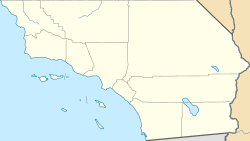
Walter Marvin Knott was an American farmer who founded the Knott's Berry Farm amusement park in California, introduced the Boysenberry, and made Knott's Berry Farm boysenberry preserves.

Knott's Berry Farm is a 57-acre (2,500,000 sq ft) theme park located in Buena Park, California, owned and operated by Cedar Fair. In March 2015, it was ranked as the twelfth-most-visited theme park in North America, while averaging approximately 4 million visitors per year. The park features over 40 rides, including roller coasters, family rides, dark rides, and water rides.
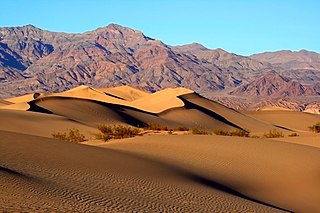
The Mojave Desert is a desert in the rain shadow of the southern Sierra Nevada mountains and Transverse Ranges in the Southwestern United States. Named for the indigenous Mohave people, it is located primarily in southeastern California and southwestern Nevada, with small portions extending into Arizona and Utah.

The Mojave River is an intermittent river in the eastern San Bernardino Mountains and the Mojave Desert in San Bernardino County, California, United States. Most of its flow is underground, while its surface channels remain dry most of the time, except for the headwaters and several bedrock gorges in the lower reaches.
Bagdad is a ghost town in the Mojave Desert, in San Bernardino County, California.

Yermo is an unincorporated community in the Mojave Desert in San Bernardino County, California. It is 13 miles (21 km) east of Barstow on Interstate 15, just south of the Calico Mountains. Its population was estimated at 1,750 in 2009.

Daggett is an unincorporated community located in San Bernardino County, California in the United States. The town is located on Interstate 40 ten miles (16 km) east of Barstow. The town has a population of about 200. The ZIP code is 92327 and the community is inside area code 760.
Oro Grande is an unincorporated community in the Mojave Desert of San Bernardino County, California, United States. It lies on the city boundary of Victorville and Adelanto. It is at 3,000 feet (910 m) elevation in Victor Valley north of the San Bernardino mountain range. It is located on old Route 66 near Interstate 15 between Victorville and Barstow. The ZIP code is 92368 and the community is inside area codes 442 and 760. Less than 1,000 residents live in the unincorporated area.
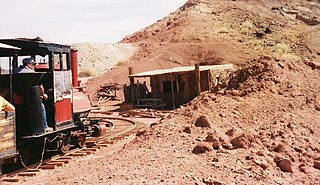
The Calico & Odessa Railroad is a 2 ft 6 in narrow gauge heritage railroad in the ghost town of Calico, California, headquartered in Yermo, California. It was named for the town and mountain range of Calico and the nearby Odessa Canyon.
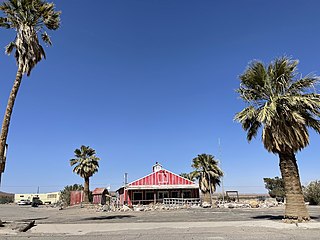
Newberry Springs is an unincorporated community in the western Mojave Desert of Southern California, located at the foot of the Newberry Mountains in San Bernardino County, California, United States. Newberry Spring is a spring that in the 19th century supplied water to the local Santa Fe Railway and originally was a camping place. The population at the 2000 census was 2,895.

The Calico Mountains of California are a mountain range located in the Mojave Desert. The range spans San Bernardino and Inyo counties in California.
Ludlow is an unincorporated community in the Mojave Desert on Interstate 40, located in San Bernardino County, California, United States. The older remains of the ghost town are along historic Route 66.

Ivanpah was a short-lived silver mining town located in San Bernardino County, California, United States. It was founded in 1869 and existed until at least the mid-1880s.
The Calico Print was a newspaper, established in 1882 and published during the heyday of the silver mining camp of Calico, California prior to 1902. The Calico Print was also the name of a monthly, later bi-monthly, periodical of the mid-20th century, and contained "Tales and trails of the desert West."
The Calico Peaks are geologically and historically colorful mountains in the Calico Mountains Range in the Mojave Desert of San Bernardino County and Inyo County, California. They are located just north of Barstow, Yermo, and Interstate 15.
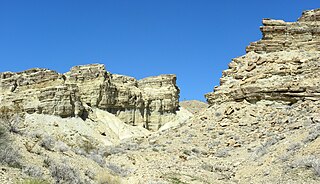
The Barstow Formation is a series of limestones, conglomerates, sandstones, siltstones and shales exposed in the Mojave Desert near Barstow in San Bernardino County, California.
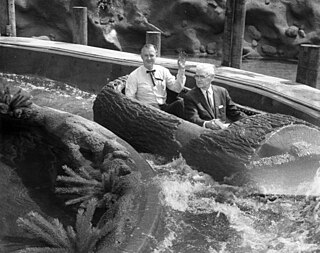
Wendell "Bud" Hurlbut (1918–2011) was a designer, builder, entrepreneur, and one of the first creators of theme parks in the United States.
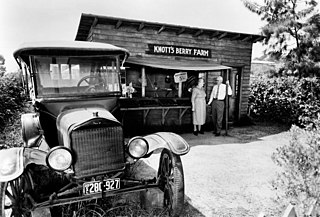
The Knott's Berry Farm amusement park in Orange County, California, originated from a berry farm owned by Walter Knott (1889–1981). In the 1920s, Knott and his wife, Cordelia, sold berries, berry preserves and pies from a roadside stand beside State Route 39, near the small town of Buena Park.

The Waterloo Mining Railroad, also known as the Calico Railroad or Daggett-Calico Railroad, was a 3 ft narrow gauge railroad built to carry silver ore from the mines in the Calico Mountains north of Calico to the mills located at Elephant Mountain near Daggett, California, from 1888 to 1903.

Paul von Klieben was the key employee of Walter Knott in the early years of Knott’s Berry Farm and the restoration of the ghost town of Calico, California. He started his career in Chicago as a commercial artist and portrait painter. In 1941, he joined Knott’s Berry Farm in Buena Park, California as a staff artist, then served as art director there from 1943 until 1953. He traveled to ghost towns in the West, and designed most of the Ghost Town section of Knott’s Berry Farm. He created concept art for most of the buildings that were built there. He also drew up floor plans, oversaw the construction of buildings, and even spent some time painting concrete to look like natural rock. His Old West paintings and murals adorned the walls of many structures in the park, and his art was used extensively on menus, brochures, catalogs and other Knott’s documents.

